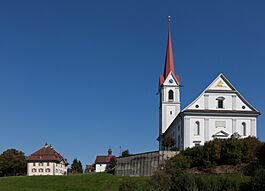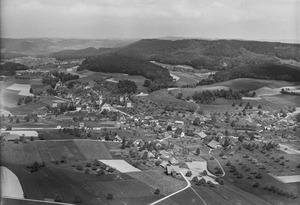Pfaffnau facts for kids
Quick facts for kids
Pfaffnau
|
||
|---|---|---|
 |
||
|
||
| Country | Switzerland | |
| Canton | Lucerne | |
| District | Willisau | |
| Area | ||
| • Total | 17.68 km2 (6.83 sq mi) | |
| Elevation | 507 m (1,663 ft) | |
| Population
(Dec 2020 )
|
||
| • Total | 2,674 | |
| • Density | 151.24/km2 (391.72/sq mi) | |
| Postal code |
4915,6264
|
|
| Surrounded by | Altbüron, Brittnau (AG), Grossdietwil, Melchnau (BE), Murgenthal (AG), Reiden, Roggliswil, Roggwil (BE), Untersteckholz (BE) | |
Pfaffnau is a small town, also called a municipality, located in the Willisau district. It's part of the canton of Lucerne in Switzerland. Pfaffnau is special because it has two main parts: the village of Pfaffnau itself and the historic Former Monastery of St. Urban.
Contents
Discovering Pfaffnau's Past
Pfaffnau was first mentioned in old records way back in the year 924. It was known by names like Fafanhaa or Fafana. Later, in 1173, it was called Phafena. This shows that people have lived in this area for a very long time!
Exploring Pfaffnau's Geography
Pfaffnau covers an area of about 17.57 square kilometers (about 6.78 square miles). A large part of this land, about 65%, is used for farming. Forests cover about 24% of the area.
Around 10% of Pfaffnau is covered by buildings and roads. A very small part, less than 1%, includes rivers or lakes. The municipality is located in a hilly area in the northwest part of the Lucerne canton. It sits right on the border with the cantons of Bern and Aargau.
Besides the main village of Pfaffnau, there are also smaller communities called hamlets. These include Burg, Buttenried, Murhof, Nuttele, Sagen, Schuelerslehn, and Sankt Urban.
Understanding Pfaffnau's Population
Pfaffnau has a population of about 2,700 people. As of 2008, about 8.5% of the people living here were from other countries. Over the past ten years (from 2000 to 2010), the number of people living in Pfaffnau grew slightly.
Most people in Pfaffnau, about 94%, speak German as their main language. Other languages spoken include Serbo-Croatian and Albanian.
In 2010, about 22% of the population were children and teenagers (under 20 years old). Adults (ages 20-64) made up about 62% of the population. Seniors (over 64 years old) were about 16% of the residents.
The chart below shows how Pfaffnau's population has changed over many years:

Important Heritage Sites in Pfaffnau
Pfaffnau is home to some very important historical buildings. These are recognized as Swiss heritage sites of national significance. They include:
- The Former Monastery of St. Urban.
- The Catholic Parish Church of St. Vinzenz, which has a cemetery chapel.
- The rectory (the priest's house) with its old tithe barn.
These sites are important parts of Switzerland's history and culture.
Pfaffnau's Economy and Jobs
In 2011, Pfaffnau had a low unemployment rate, meaning most people who wanted to work had jobs. In 2008, over 1,300 people worked in the municipality.
Jobs in Pfaffnau are divided into three main types:
- Primary sector: This includes jobs like farming and forestry. About 200 people worked in this area.
- Secondary sector: This involves manufacturing and construction. Around 170 people had jobs here.
- Tertiary sector: This is the largest sector, with about 940 people working in services. This includes jobs in sales, transportation, hotels, education, and especially health care.
Many people who live in Pfaffnau also travel to other towns for work. At the same time, many people come into Pfaffnau to work. About half of the working population uses a private car to get to work.
Religion in Pfaffnau
According to the 2000 census, most people in Pfaffnau are Roman Catholic, making up about 70% of the population. About 15% belong to the Swiss Reformed Church. There are also smaller groups of people who are Orthodox Christians, other Christians, Muslims, and Hindus. Some people do not belong to any church.
Education in Pfaffnau
Education is important in Pfaffnau. About a third of the population has completed upper secondary education. This is education after middle school. About 9% of the population has gone on to get higher education, like attending a university or a specialized college (a Fachhochschule).
Pfaffnau also has its own public library, called the Schul- und Gemeindebibliothek Pfaffnau. In 2008, the library had over 3,800 books and other items. It loaned out more than 4,300 items that year, showing that people in Pfaffnau love to read!
Images for kids
See also
 In Spanish: Pfaffnau para niños
In Spanish: Pfaffnau para niños











